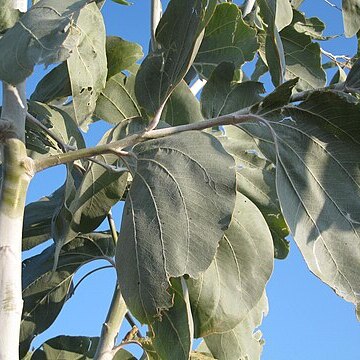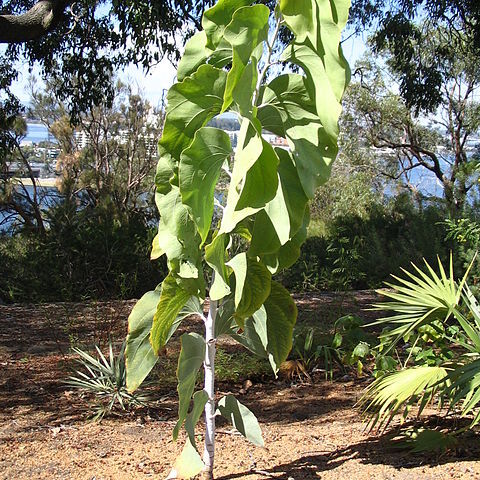Pruinose shrub or tree to 6 m high. Branchlets terete, glabrous. Phyllodes inequilaterally elliptic to ovate, shallowly falcate, 12–42 cm long, 6–17.5 cm wide, very unequal at base, 2–4-times crenate on upper margin, obtuse, coriaceous, glabrous, with 4 or 5 prominent longitudinal veins confluent with lower margin at base, closely reticulate between main veins. Inflorescences in terminal or axillary panicles 11–50 cm long; peduncles 8–20 mm long, single or fascicled, glabrous; heads globular, 6–8 mm diam., 50–85-flowered, golden. Flowers 5-merous; sepals ¼–½-united. Pods narrowly oblong, straight, to 17 cm long, 2–4 cm wide, subwoody, coarsely reticulate. Seeds transverse, broadly elliptic to oblong-elliptic, 9–12 mm long, subnitid, brown with brown-black periphery; aril apical.
More
An evergreen tree. It grows up to 2-7 m tall and about 2-4 m wide. The stem is slender and erect. It has few branches. The stem grows from a woody swelling which has dormant buds. The leaves (phyllodes) are silvery blue. They are broad and sickle shaped. They are 12-30 cm across. They look like an elephant's ear. They have 3 or 4 clearly seen veins which run along the leaf. These leaves can also grow on the trunk and last for many years. These leaves hang vertically. The leaves are used to wrap food. The flowers are dense golden or yellow balls. They are 1-2 cm across. They occur in flower clusters at the ends of branches. The pods are brown. They are woody pods 10-13 cm long and 2.5-3 cm across. They are flat. The pod is constricted between the seeds. The seeds are 1.2 cm long.



